Searching for Beavers on the River Otter
There’s a quiet satisfaction that comes from tracking down an animal on its own terms. Especially when that animal is a beaver.
I recently spent two days on the River Otter in East Devon looking for Eurasian beavers — the now-thriving descendants of a reintroduction effort that began more than a decade ago. My goal was simple: observe, photograph, and get a better feel for the rhythms of a species that’s quietly reshaping parts of the British landscape.
This post is a breakdown of the experience, what worked, what didn’t, and some practical advice for anyone keen to find and photograph beavers in the wild.
What you need to know, before you go…………
As with any new photo subject, before you head out into the field it’s worth spending a little time reading around the subject, getting to know the animals behaviour and field signs, and crucially the best places and times to see them.
Beavers were once widespread across Britain but were hunted to extinction in England by the 16th century, mainly for their fur, meat, and castoreum (a glandular secretion used in perfumes and medicine). Over the last few decades, there’s been a growing interest in bringing them back, not just as a native species, but also for their ecological role as natural engineers. Their dams and digging can restore wetlands, reduce flooding, and boost biodiversity.
Where to See Beavers in the Wild in England (Free-living, Unfenced)
River Otter, East Devon: This is the best-known site and the only officially sanctioned wild population in England. Look near Otterton and Budleigh Salterton around dawn or dusk.
Kent (River Stour catchment, Sandwich to Ashford): Surveys show around 50 active territories, likely supporting up to 60 beavers. Sightings from Sandwich to Conningbrook lakes near Ashford
River Tamar and Tributaries (Devon/Cornwall border): A small, unlicensed population is known here, but they are less easy to see and not officially monitored.
Avon catchment, South Gloucestershire/Wiltshire border: A few individuals have been sighted here, thought to be escapees or unofficial releases.
More reintroductions are in the pipeline, and the trend is clearly toward greater acceptance of beavers as a tool for ecological restoration.
From what I could find there are several organisations that offer Beaver watching trips, but few (if any) are tailored to photographers, and they all seemed relatively pricey for what is essentially just access to information about where the beavers are. I decided I would take a more practical approach and simply head towards my nearest known beaver hot spot and ask the locals for help in finding them!
If you’re looking for wild sightings, the River Otter is your best bet (and luckily for me is under 2 hours from home!). Quiet evenings near the river, especially in summer, give you the best chance. From what I had read I needed to pick a slow stretch of water, bring a flask, sit down, and stay patient!
Day One: Heat, lots of field signs, and a single beaver sighting
I set off from home on Tuesday just before lunch. It had been hot for days — not ideal for beaver spotting, as they’re mostly crepuscular and tend to lie low during the heat of the day. Still, I wanted to scout the area and look for signs.
On arrival at my digs for the night (The Kings Arms, Otterton) I asked about recent beaver sightings and was helpfully told by the bar maid that she’d heard that North of the mill had been good recently, although South was their usual haunt! Armed with that thoroughly conflicting information I decided to head North and set for the river. That first afternoon walk was uneventful in terms of sightings, but not a waste. I found plenty of beaver signs: gnawed trees, stripped balsam stems, and wood chips (see pics below). These clues gave me a general sense of territory, even if the animals themselves remained out of sight. Its a beautiful stretch of river and even if I’d not seen any beaver sign it would have been a good afternoon’s amble.
After quick return to the pub for some grub (a REALLY GOOD bacon cheeseburger and a pint of cider) I returned to the river just before sunset, and this time decided to head South of the mill, towards what was the beavers supposedly more frequent haunt. The light was soft, temperatures had dropped, and the river was calm. This is where I struck it lucky and after just a few hundred yards I bumped into a local couple who armed with binos were scanning the river. Not one for being shy, I asked for help and they told me they were regular beaver watchers and knew the stretch of water very well, visiting most evenings. I tagged along with them as they explained whereabout the beavers had previously had lodges, what to look out for (apparently the sound of the beavers crunching Himalayan Balsam from the reeds is heard more often than they are seen) and where regular feeding areas were. After about 10 minutes they pointed to a willow in the distance and told me that around this willow, and the footbridge just a couple of hundred yards before, had been the best spots for turning up beavers over recent weeks.
I chose to settle myself just beyond the willow, by a quiet section of water where the banks where lined with reeds, and settled myself in for a wait. After a quiet hour of not a lot other than Sedge Warblers, a mallard and passing walkers (many who seemed to be here for the beavers), a group of about 8 watchers appeared, led by 2 members of the Devon Wildlife Trust, who stopped between me and the willow. I knew from my research that the Devon Wildlife Trust run beaver watching events, and felt quite smug that my homework (and bumping into the couple on the bank) had paid off an I was in the right spot. We all waited around for another 20 minutes or so, all constantly checking the reeds, and up and down river for the slightest sign, or ripple that might suggest a beaver was close by. Just then a single beaver was seen against the far bank just a little upstream from me— hugging the vegetation and barely breaking the surface. It quickly dived underwater and as luck would have it headed straight in my direction. It came to rest just opposite me, tucked in against the reeds, under an overhanging tree, just about in sight, but not really well positioned for a great photo.
It stayed visible for about 7 or 8 minutes, mostly still and watchful. Then it silently slipped downstream toward the estuary, vanishing into the undergrowth. No drama, no textbook photography moment, just a quiet, wild encounter — and exactly the kind I value most.
Day Two: Dawn Patrol, Empty Banks
I was back at the riverbank just before dawn the next morning. These are the kinds of starts photographers get used to — bleary-eyed, kit packed the night before, hoping the early rise pays off. In terms of kit, I was keeping it simple and light. A single camera body and telephoto lens on a harness, and a small bag with spare cards, batteries, cleaning kit and a 10-18mm Macro in case I wanted to photograph anything up close.
Heading South again, I was at the spot where I had seen the beaver the previous night, but despite lots of walking up and down looking and listening I couldn’t find a beaver. Signs were everywhere. Tail drag marks across the muddy banks, more balsam chewed down to nubs, and some clean gnaw lines on young willow. These weren’t just old signs, either. Beavers had been through here overnight!
Finding a sheltered bay on the river with a shingle beach, I found a good spot where I had a clear view both up and downstream and settled in for a long wait. It was significantly colder than yesterday and having felt the heat the afternoon before I had only thrown on short and a light short sleeved shirt when I left the hotel at 0445……….and I was really feeling the cold as the wind picked up. I popped on my windproof smock and hunkered down, staying put for nearly four hours, with just an Egret, a Cormorant, and a Juvenille Grey Wagtail for company!
It’s a common story when working with elusive species: the signs show up more reliably than the animals. That’s part of the deal.
Field Signs to Look For
If you’re hoping to track Eurasian beavers yourself, understanding field signs is essential. These animals are cryptic, mostly active around dusk and dawn, and don’t make much in the way of vocalisation. But they leave clear evidence behind.

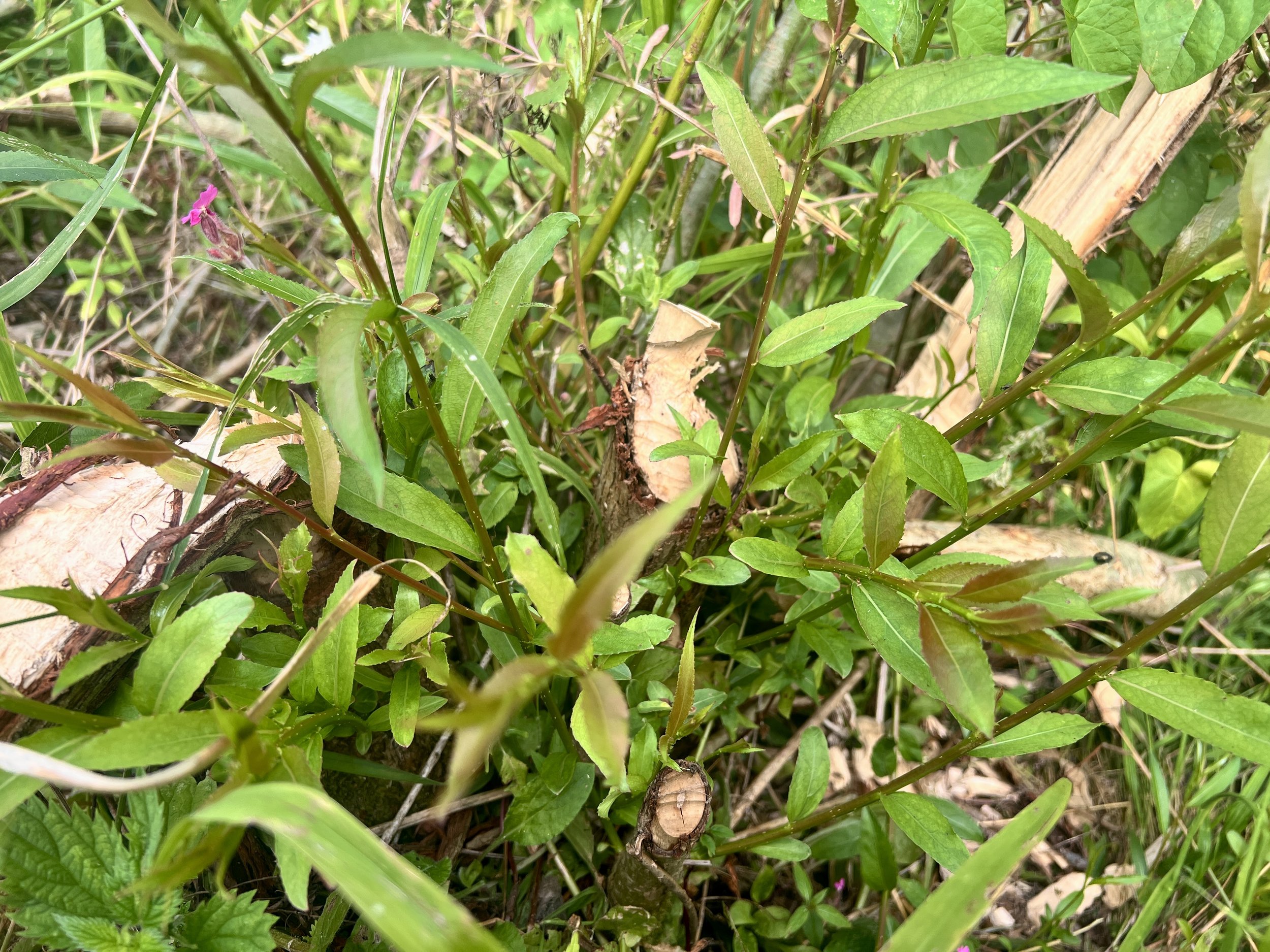
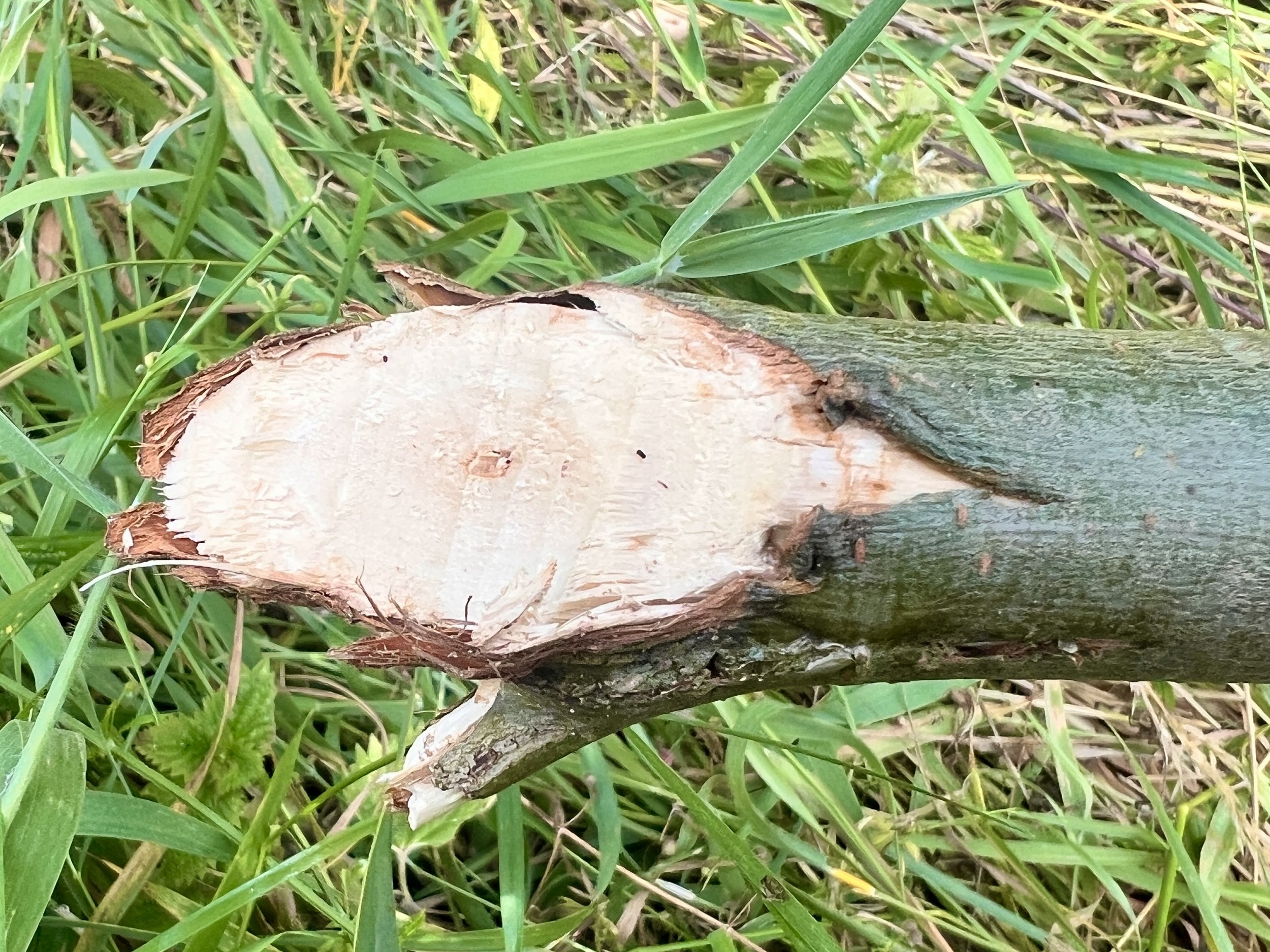
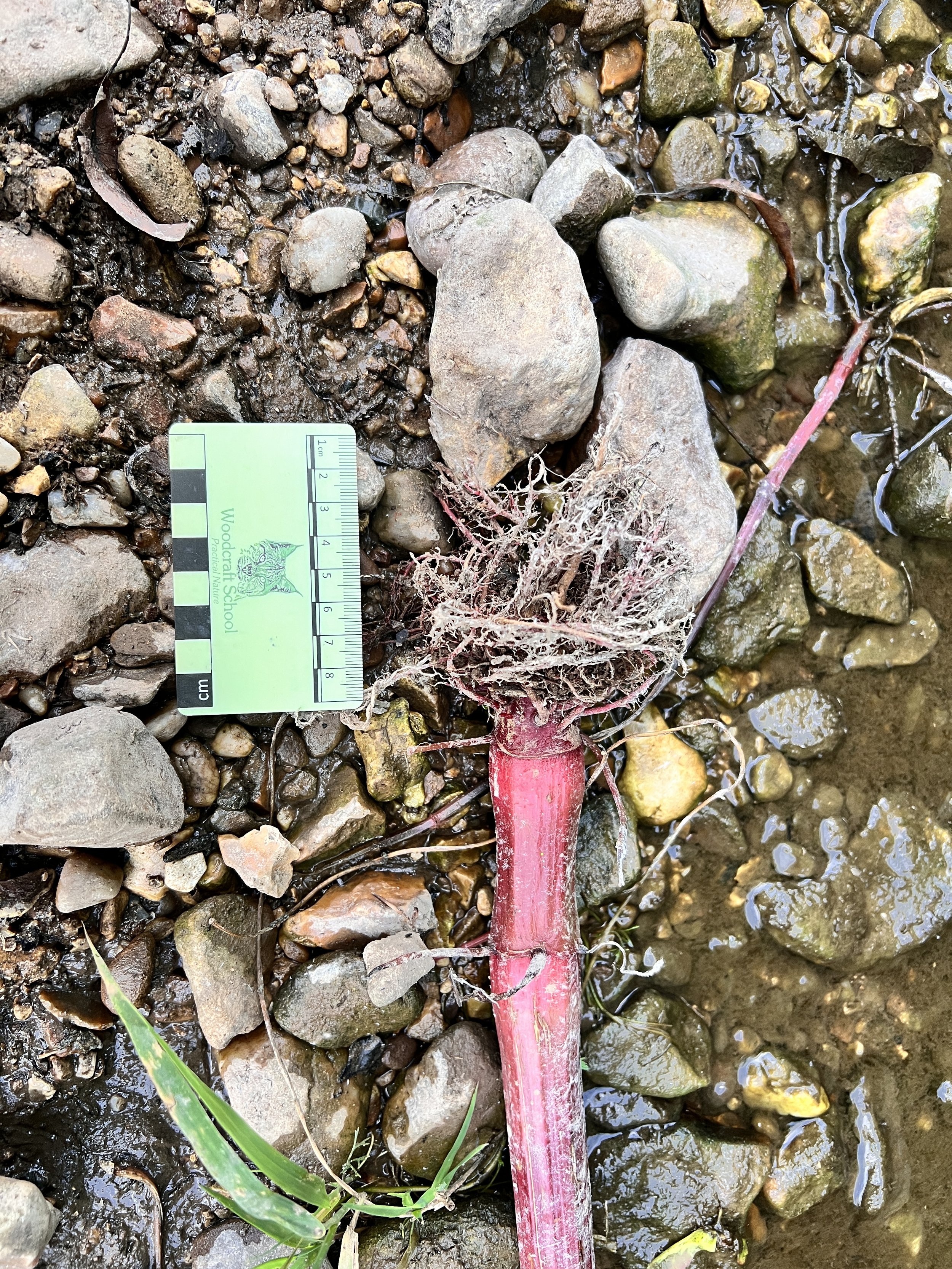
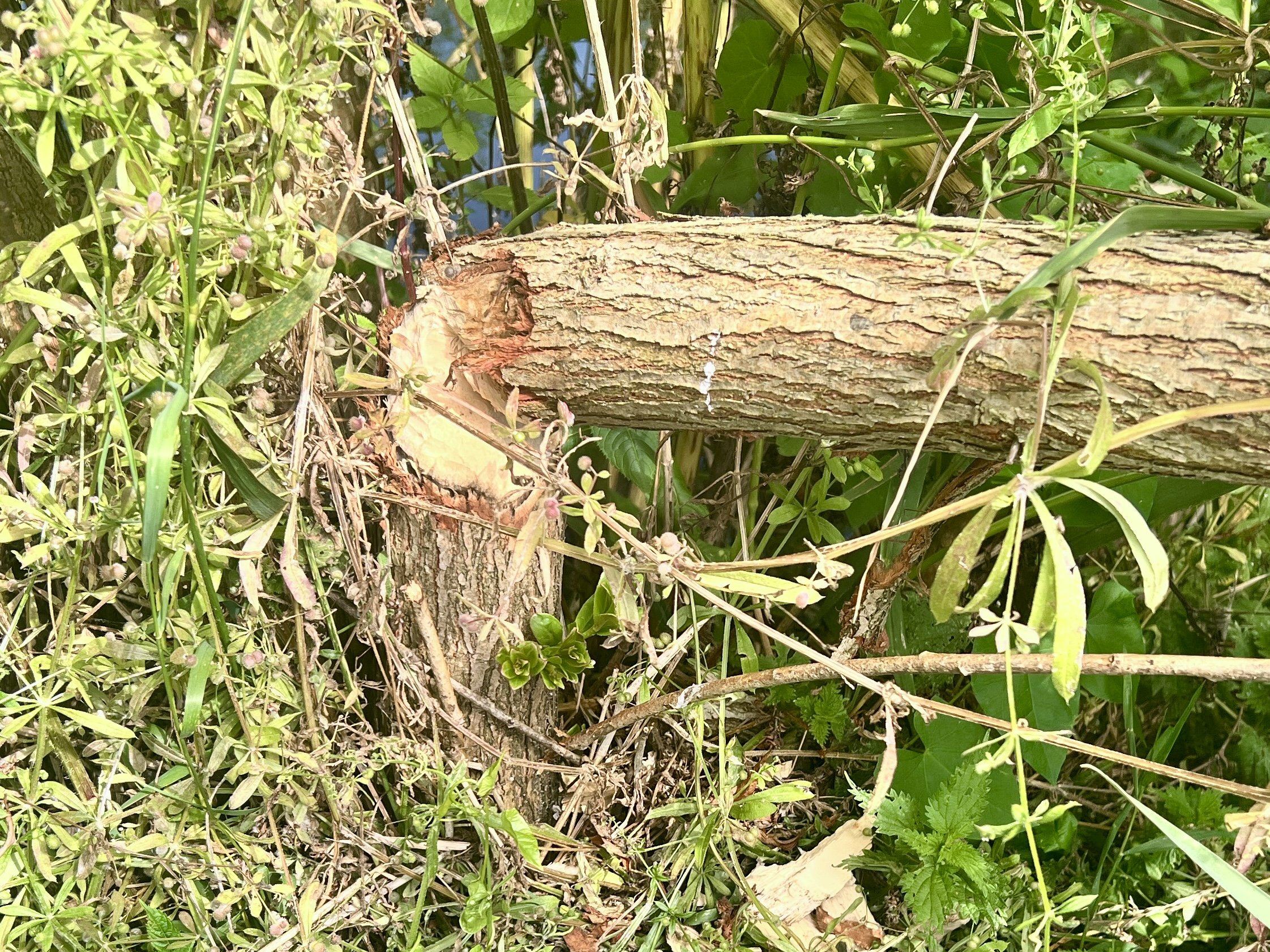
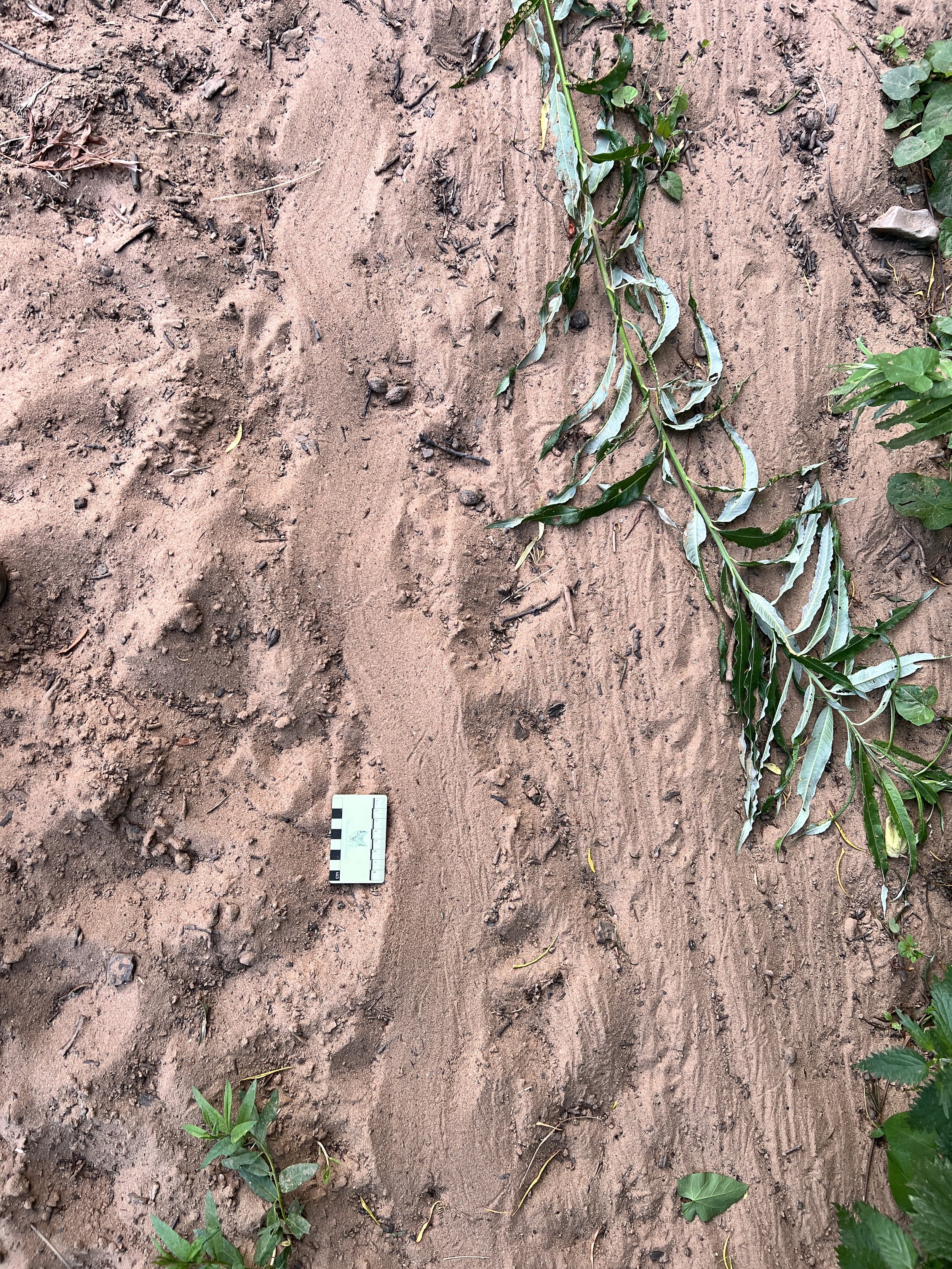
Here are the main things to look for:
Wood Chips: Slithers of 2-4cm wood from where the beavers have been busy cutting down trees and bushes.
Gnawed wood: Beavers leave chisel-shaped tooth marks, often at a 45-degree angle. Look for saplings or branches with clean, pale cuts.
Feeding signs: Himalayan balsam is a favourite food. Look for stems with the tops neatly bitten off, or half-stripped stalks along the water’s edge.
Tail drags and paths: Smooth muddy trails across banks or well-worn entry points into the water often signal repeated use.
Vegetation floating or dragged on to banks: Where its present beavers love Himalayan Balsam and it can be found uprooted and chewed in the water and on the banks.
Dung: Often found in shallow water or along grassy margins, beaver scat is soft, greenish, and full of vegetation (not photographed)
Lodges and burrows: In the UK, beavers often dig burrows into riverbanks rather than build large lodges. These are usually low, subtle holes with well-worn muddy entrances (not photographed).
A sit mat is essential if you plan to stay still for any length of time — the ground’s rarely comfortable, and after an hour or two your knees and back will thank you. I also forgot my flask of tea, which I won’t do next time.
Technical Photography Advice for Beavers in Low Light
Photographing beavers is a good field test of your camera setup and technique. You’re dealing with a low-profile, low-light, water-based mammal that often stays behind cover and rarely gives you long. Here’s some advice that might help:
1. Handheld Is Often Best
On this trip, I used my Canon R5 paired with the RF 200–800mm lens — a flexible, surprisingly sharp setup that gave me reach without the weight penalty. I left the tripod behind on purpose. Along a riverbank, you’ll often be repositioning, crouching low, or adjusting your angle to cut through reeds or avoid water glare. Handheld makes all of that easier.
If you prefer more support, consider a monopod or a beanbag on your knee — enough to stabilise, but without locking you to one place.
2. Know Your ISO Limits
Shooting around dawn and dusk means you’re often working in marginal light. Don’t be afraid to push your ISO — on the R5, I was happy to go up to 6400 or higher. Noise reduction in post-processing can clean things up, and I’d much rather recover a grainy shot than lose sharpness to motion blur.
That said, it’s worth testing your camera’s limits beforehand. Know where detail starts to fall apart, and expose carefully to the right if possible to preserve shadow detail.
3. Use the Right Autofocus Mode
If your subject is low in the water and partially hidden, autofocus can struggle. I found animal eye AF worked on the beaver’s profile a few times, but not reliably. When in doubt, switch to a small single-point AF, aim just behind the eye, and recompose as needed. You’ll miss less this way.
If there’s low contrast or water glare, manual override can sometimes help nudge focus into place.
4. Shutter Speed Matters More Than Aperture
With slow-moving animals like beavers, 1/250s is often enough — but if there’s any current or movement, I’ll try to keep to 1/500s minimum. If that means shooting wide open at f/6.3 or even f/8 and pushing ISO higher, I’ll take the trade.
When a subject is mostly submerged, depth of field doesn’t need to be deep. Get focus on the eye ridge and don’t worry too much about the body.
5. Shoot in Bursts – Then Pause
Beavers don’t like sudden movement, but a quiet, continuous burst can help capture micro-expressions, ripples, or subtle shifts in posture. I’ll often shoot a 3–5 frame burst when the beaver pauses or turns, then pause for a while to avoid overfilling cards or missing a better angle.
Also, keep checking your histogram — the dark brown of a beaver against water can fool metering systems into underexposing.
6. Don’t Forget the Habitat Shots
Close-ups are great, but wide-angle environmental shots help tell the full story. I always carry a 10–18mm wide-angle lens for shooting tree gnaws, drag marks, or beaver-chewed stems up close. These signs add context, and a properly composed image of a wood chip pile can often be more evocative than a distant subject.
Seasonal Advice
Early July is a challenge — the banks are thick with vegetation, and lines of sight are short. You’ll find plenty of beaver sign, but seeing the animals can be tough unless you get lucky with a clear channel or bold individual.
In early spring, before full leaf-out, the banks are more open and tracks are easier to spot. You’ll also get more visible evidence from the winter months — exposed burrows, chewed trunks, and bare waterlines.
Late August into September is another good time. Vegetation starts to die back, juveniles are more active, and families are feeding heavily before autumn.
Local Tips: Otterton and Nearby Reserves
If you’re planning to base yourself near the River Otter, I recommend the King’s Arms in Otterton. It’s only five minutes from the river, serves good food and cider, and makes an ideal jumping-off point for early starts and late finishes.
While you’re in the area, don’t miss these local highlights:
Exe Estuary: Excellent for waders, gulls, and waterfowl. Visit at high tide when birds are pushed closer to shore.
East Devon Heaths: Look for Dartford Warblers and Nightjars in late summer. Early mornings or warm evenings give you the best chance.
Otter signs: Keep your eyes open along the riverbanks — beaver sign is abundant, but otters are around too. Look for spraints on flat stones and low trails through reeds.
Final ThoughtS
I didn’t come away with the perfect image. But I didn’t need to. This was just my first visit………..
What I got was a quiet, wild moment with an animal that only recently returned to this part of the world and is now thriving because people chose to give it space and time. For any conservationist, that’s a reward in itself.
For photographers, it’s a challenge worth taking on. Beavers won’t come to you. You have to go to them, learn the signs, sit in the shadows, miss shots, and come back again. But when it all lines up, the light, the stillness, and the slow ripple of a brown shape drifting through reed and shadow, it’s worth it.
Every time.
Beaver FAQ
Are there beavers on the River Otter?
Yes. The River Otter in Devon is home to England’s first wild breeding population of beavers for centuries. The reintroduction was made permanent in 2020 after a five-year trial.
Are beavers native to the UK?
They are. Beavers were once widespread but were hunted to extinction about 400 years ago. Today, carefully managed reintroductions are restoring them to rivers across Britain.
What do beavers eat?
Beavers are herbivores. They eat aquatic plants, grasses, and tree bark, particularly willow, aspen, and birch. In summer, they graze bankside vegetation; in winter, they rely more on bark and twigs.
Do beavers build dams in the UK?
Yes, but not always. On big rivers like the Otter, they often don’t need dams because the water is deep enough. They are more likely to build dams on smaller streams and ditches to create ponds.
When is the best time to see beavers?
Dawn and dusk are best. Beavers are most active in low light, often emerging from lodges or burrows to feed and swim. Sit quietly by the river and watch for ripples and silhouettes.
How can you tell if beavers are nearby?
Look for gnawed tree stumps, wood chips, slides into the water, and piles of cut branches. Beavers leave very distinctive feeding signs along riverbanks.
Are beavers dangerous?
Not to people. Beavers are shy, and encounters are usually brief. The main risk is to trees near water, which they fell for food and building material.
Why are beavers important?
They’re known as “ecosystem engineers.” By felling trees and creating ponds, beavers slow water flow, reduce flooding risk, improve water quality, and create habitat for countless other species.












